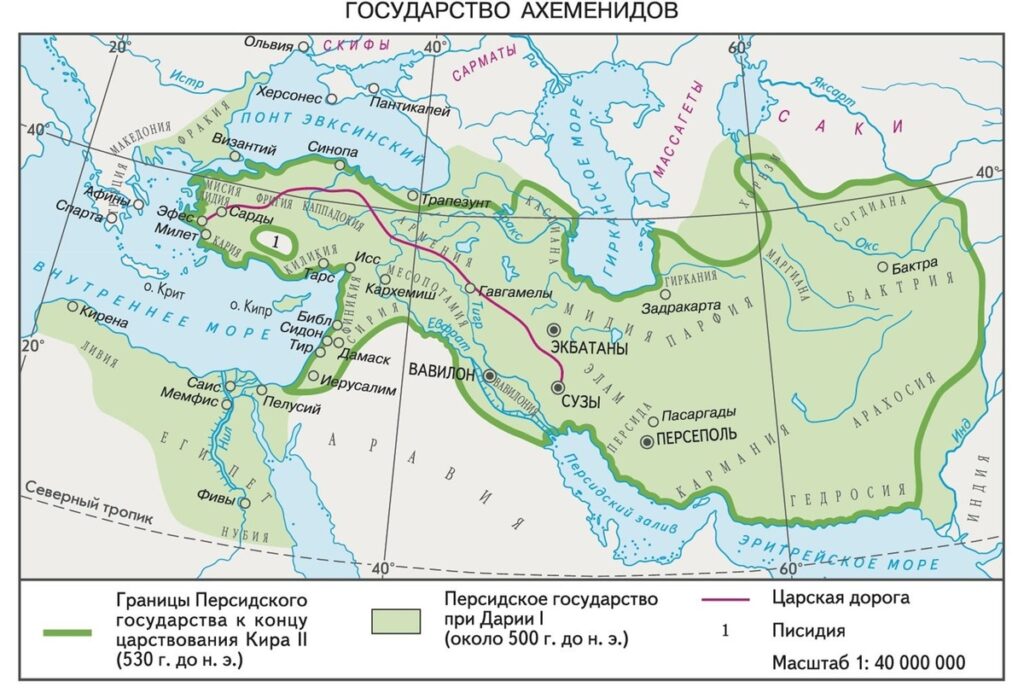The modern republics of Turkmenistan, Uzbekistan and Kazakhstan are partially located on the territory of the ancient state of Khorezm, which was first mentioned in sources from the 7th century BC.
The Great Silk Road passed through Khorezm, and by VI-IV centuries B.C. it was a state of developed irrigation agriculture, crafts and trade with centers in Kyuzeligyr and Kalalygyr. It is interesting that already at that time there was a chronology.
The inhabitants of Khorezm were Iranians and spoke the eastern Iranian language, which existed until the adoption of Islam and Turkization of the state, which was deprived not only of language, but also of its ancient culture.

State of Khorezmshahs Photo from open access
According to some historians, Khorezm meant «feeding land», others believed that «low land».
Khorezm scholar-encyclopedist Abu Reyhan Al-Biruni (973-1048) in his work «Monuments of Past Generations» gives information about the Turks of Khorezm:
«They (inhabitants of Khorezm) counted years from the beginning of settlement (of their country), which occurred 980 years before Alexander, and then they began to count years from the arrival in Khorezm of Siyavush, son of Kaikaus and the enthronement there of Keyhusrau and his descendants, who moved to Khorezm and spread his power over the kingdom of the Turks. It was 92 years (from the beginning) of the settlement of Khorezm«.
True, then it was not Turks, but Iranians.
The capitals of Khorezm
In the Middle Ages, the capital of Khorezm was the prosperous Gurgandja, whose inhabitants were skillful craftsmen, famous for products made of ivory and ebony.
Yakut al-Hamawi, who visited Gurgandja in 1219, wrote: «I do not think that in the world there was a city similar to the main city of Khorezm by the abundance of wealth and the size of the capital, the large population and the proximity to the good and fulfillment of religious precepts and faith.
In the middle of the XIV century, after the collapse of the Golden Horde, the capital of Khorezm was the city of Urgench, and from the second half of the XVII century — Khiva, which was filled with monumental architectural structures during the reign of the Uzbek dynasty of Kungrats.
After that, in Russian sources Khorezm began to be called Khiva Khanate, although in official documents and on coins it continued to be called Khorezm.
Under Achaemenid rule
In VI-IV centuries BC Khorezm was conquered by Cyrus II and was under the rule of Achaemenids, the viceroy of Khorezm, Bactria and Parthia was Cyrus’ son Tanoxiarka. State documents of that period were conducted in Aramaic, In the V century BC on the basis of Aramaic writing was developed Khorezmian writing. Khorezmian language belonged to the group of East Iranian languages.

Achaemenid state Photo from open access
Religion of Khorezm
The religion of the Khorezmians in those times was Zoroastrianism or Mazdaism with a single god Ahura-Mazda, they were fire worshippers, and the Khorezmian tradition was somewhat different from the Persian one. For them earth and fire were considered sacred, so the deceased could not be buried in the ground or consigned to fire.
Zoroastrians built huge Towers of Silence, where the dead were taken to be eaten by birds and beasts.

Zoroastrian Tower of Silence I century Photo from open access
Khorezm gained independence from the Achaemenids even before the campaigns of Alexander the Great, who destroyed the Achaemenid power.
However, in the II century BC Khorezm was conquered by nomadic Turkic-speaking tribes and about 175 BC became part of Kangyu.
From 305 to 995 Khorezm was ruled by the Afrigid dynasty, during this period in Khorezm appear representatives of the Hun people, whose language was close to the Turkic languages.
At the end of the 4th century, the Hionites, an Iranian nomadic tribe, appeared in southern Khorezm.
Coming of Islam
Beginning in the 6th century, Khorezm was dependent on the Turkic Kaganate, and in 712 the conquest of Khorezm took place.
In 712 there was a conquest of Khorezm by Arab commander Kuteiba ibn Muslim, who began to carry out repressions against the scholars of Khorezm and destroyed the written language of Khorezmians, carrying out Islamization of the population.
Here is how Al Biruni wrote about it in «Chronicles of Past Generations»: «and by all means Kuteiba scattered and destroyed all those who knew the writing of the Khorezmians, who kept their legends, all the scholars who were among them, so that all this was covered with darkness and there is no true knowledge of what was known from their history at the time of the coming of Islam to them.»
Thus all true knowledge of Khorezm was destroyed, as it reminds painfully of the Christianization of Russia.
The population of Khorezm gradually became Turkic and gradually the Turkic written-literary language — Chagatai language — began to take shape.
By the beginning of XIII century the territory of Khorezm covered the present Uzbekistan and Turkmenistan, 9/10 of Iran, half of Azerbaijan, Afghanistan, Tajikistan and Kyrgyzstan and southern Kazakhstan. It was a territory of several million square kilometers and 20 million people.
Invasion of Genghisids
Genghis Khan’s invasion put the final cross on the history of Khorezm, although the Khorezmians had themselves to blame. Genghisids wanted to establish diplomatic relations, but Khorezmians executed first the merchants who came to them, and then the ambassadors.
Such, as we know, Genghisids did not forgive, we know the situation from the battle at Kalka in 1223, when Russian princes executed two embassies of Genghisids, it ended with Batyi’s invasion of Russia in 1237 and the massacre of the traitor princes.
In 1219 Genghis Khan has fallen on Khorezm all power of the army.

The last Khorezmshah. Photo from open access
The last Khorezmshah Aladdin Mohammed II did not dare to give a general battle, and distributed his army in the cities and fortresses of the state, but they could not withstand and fell.
Otrar, Khodjent, Tashkent (Chach), Bukhara, Samarkand, Balkh, Merv, Nishapur, Herat, Urgench were subjected to destruction, and their inhabitants were mostly killed.
Khorezmshah fled with a small detachment to the islands of Abeskun, which was the name of the sea harbor at the mouth of the Gurgan River at that time.
According to Gumilev, there lived there patients with leprosy, and since the shah at that time was seriously ill with pneumonia, he had little chance of survival. He lived on the island for about a year, dying he transferred power to Jalaliddin Mankburni, announcing: The bonds of power broke, the foundations of the state weakened and destroyed. It became clear what the aims of this enemy were: his claws and teeth were firmly clawed into the country. Only my son Munkburne can avenge me. And so I appoint him heir to the throne.
Samarkand with Bukhara entered the ulus of Chagatai, and Khorezmian oasis — in the ulus of Djuchi together with all Turkic steppe and the Golden Horde.
However, let us not forget that the Genghisids at that time were Nestorian Christians. Historian Sergei Tolstov claimed that the culture of the Golden Horde at that time was close to that of Khorezm.
I think this is not true, the only thing that united these two cultures was the non-acceptance of Islam.
But in 1312 Khan Uzbek (1312-1340) ascended the throne in the Golden Horde and adopted Islam as the state religion.

The Timurid state. Photo from open access
In 1376 Khorezm became part of the Timurid Empire, political and economic life in this period was centered in Southern Khorezm and the cities of Khiva, Hazarasp, Khanka and Kyat even flourished to some extent, but it was already a different culture imposed by the conquerors.
Under the Timurids, in the first half of the 15th century Herat, Samarkand and Shiraz were the main literary centers of the Chagatai language, and Arabic works were translated into Turkic.
In Istanbul, the Sulayianme Library keeps the Koran with a lined translation into the Turkic language. The Uzbek language was the result of interaction between the Turkic language and the language of the Khorezmians.
After the Timurids in 1505, the Sheibanids conquered Khorezm, forming a state that included the whole of Maverannahr, Khorezm and Khorasan.
In the 16th century, the main population of Khorezm was Turkic elements, Turkmens were the second largest group, and the third were Uzbeks
In 1511, control over Khorezm passed to a new local Uzbek dynasty, the Arabshahids, who ruled until 1728, when there was a new turmoil between two Uzbek dynasties, the Mangyts and the Kungrats. The capital of Khorezm was at that time moved from Urgench (Gurgandzha) to Khiva.
Thus the once great state of Khorezm, a branch of the Persian tree, turned into the Khanate of Khiva, populated mainly by Uzbek nobility and nomads Turkmen and Karakalpaks.
The history of the Khanate of Khiva is the material for a separate article, we can only add that it was annexed to the Russian Empire in 1873.
